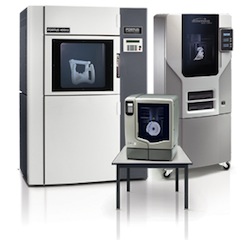Direct Digital Manufacturing: A Disruptive Technology
Direct digital manufacturing (DDM) and 3D printing are getting a lot of attention these days even though the technology has been around for over two decades. After quietly serving the rapid prototyping needs of engineers and designers for 20 years, DDM is beginning to take on all the characteristics of a disruptive technology. Something has changed.
 To find out what’s going on, we talked with Jeff DeGrange, a Stratasys Vice President. DeGrange has more than 20 years experience in manufacturing technology, including pioneering the use of DDM for production flight applications.
To find out what’s going on, we talked with Jeff DeGrange, a Stratasys Vice President. DeGrange has more than 20 years experience in manufacturing technology, including pioneering the use of DDM for production flight applications.
“There is no question that direct digital manufacturing is a disruptive technology,” he says. “As the (DDM) machines have gotten larger and faster, and more importantly, as the materials have improved, additive manufacturing is being used for an increasing wider range of applications.”
This evolution is allowing DDM to move beyond rapid prototyping and begin creating parts and tools that are suitable for production runs. This approach is already evident in aerospace and medical, industries that typically require low volumes and parts with complex geometries. And, as other industries hop on the 3D bandwagon, a substantial inventory of business cases will become available and further accelerate the growing use of this technology.
Specifically, the adoption of DDM will have a major impact on production processes. Says DeGrange, “The first thing that comes to my mind is that the need to make hard metal tooling – whether it’s fabrication or metal tooling used in conventional manufacturing processes – all that goes away. You don’t need to design it, you don’t need to build it, and you don’t need to store it in a warehouse somewhere.”
He also points out that in today’s fast-paced world, people expect products, goods and services to be delivered intact and on demand – consider the instant gratification of downloading a video or a music track over iTunes. DDM – additive manufacturing – meets those expectations in a way that conventional manufacturing does not.
And, in the process, you can realize significant savings in materials. For example, says DeGrange, drawing on his years of manufacturing experience in the aerospace industry, in a traditional fabrication process you might bring a 100 pound plate of metal to a five-access CNC machine and mill the stock down to a 10 pound part. You have just created 90 pounds of waste, or in the parlance of the aerospace industry, you have a 10:1 buy-to-fly ratio.
Because additive manufacturing only deposits the material that is needed for the part, the buy-to-fly ratio drops to nearly 1:1 with minimum waste involved in producing the finished object. A low buy-to-fly ratio also translates into less inventory and lower transportation costs. For example, in the future, a retailer like Home Depot, instead of stock piling boxes of parts in a centralized warehouse, might store and maintain a minimum inventory. When a customer buys say, a PVC elbow from the plumbing department, it could simply print up a replacement.
In the aerospace industry, the production of business jets fits the DDM low volume, high product quality scenario to a T. Typically each customer wants a customized cabin interior, specialized cooling and heating systems, and, more importantly, a reliable way to maintain those business jets for the next 20 years they will be in service. The ease and sustainability of making replacement parts or upgrades are essential to effectively maintain the aircraft over time.
DeGrange also predicts that the market for 3D printed robotic drones will grow rapidly over the next five to ten years, and not just for military applications. “The technology is made for creating a wide variety of organic shapes – devices that walk around or fly doing everything from monitoring rush hour traffic to helping a rancher in Montana with thousands of acres of grazing land find his cattle,” he says.
In addition to the aerospace industry, DDM is making significant inroads into how healthcare is delivered. One example DeGrange cites is the case of a patient who needs a knee replacement. The technology now exists to minutely scan the individual’s knee to create a comprehensive CAD file and ultimately the surgical tools needed to precisely match the patient’s geometry. Or prosthetics can be organically grown and weighted to precisely match the patient’s existing extremities.
One of the factors that may slow the widespread adoption of DDM is simple inertia. DeGrange points out that subtractive manufacturing and injection molding have been around a lot longer than additive manufacturing – it’s a mature technology with a substantial knowledge base. Although DDM has a 25-year history, it has primarily been used for product development and rapid prototyping. It is only recently that the technology is being tapped to create production parts, usually in low volume. In addition, the additive manufacturing knowledge base, when compared to traditional methods, is still in its infancy.
 Through a number of initiatives, Stratasys is working to change all that. For example, the company has a well-developed educational initiative, bringing 3D printing into the classroom. Right now, its Dimension 3D Printers are in more than 3,500 schools in all 50 states, serving more than 250,000 students for applications as diverse as engineering, architecture, CAD, archaeology, anthropology, biology and art.
Through a number of initiatives, Stratasys is working to change all that. For example, the company has a well-developed educational initiative, bringing 3D printing into the classroom. Right now, its Dimension 3D Printers are in more than 3,500 schools in all 50 states, serving more than 250,000 students for applications as diverse as engineering, architecture, CAD, archaeology, anthropology, biology and art.
At the high end, the company is touting its Fortus Production 3D Printers for production runs as well as prototyping. Based on Fused Deposition Modeling, a Stratasys invention, these machines produce parts from a variety of industrial thermoplastics – the same materials used in injection molding, such as ABS, PC, and ULTEM.
Equally as important as the continuing advances in DDM technology to its widespread acceptance in manufacturing, is the availability and understanding of the materials used in the various additive processes. To this end, DeGrange says, Stratasys is amassing a comprehensive technical database of these materials based on tests from 3rd party, independent labs. New materials mean new applications, and new applications means that direct digital manufacturing will continue to make inroads in the traditional manufacturing base.
Is 3D printing a disruptive technology? You bet, says DeGrange. And it’s only going to become more so as the technology continues to rapidly mature and, in addition to its traditional role of design and prototyping, moves into production areas that once were the sole prevue of traditional subtractive manufacturing techniques.










